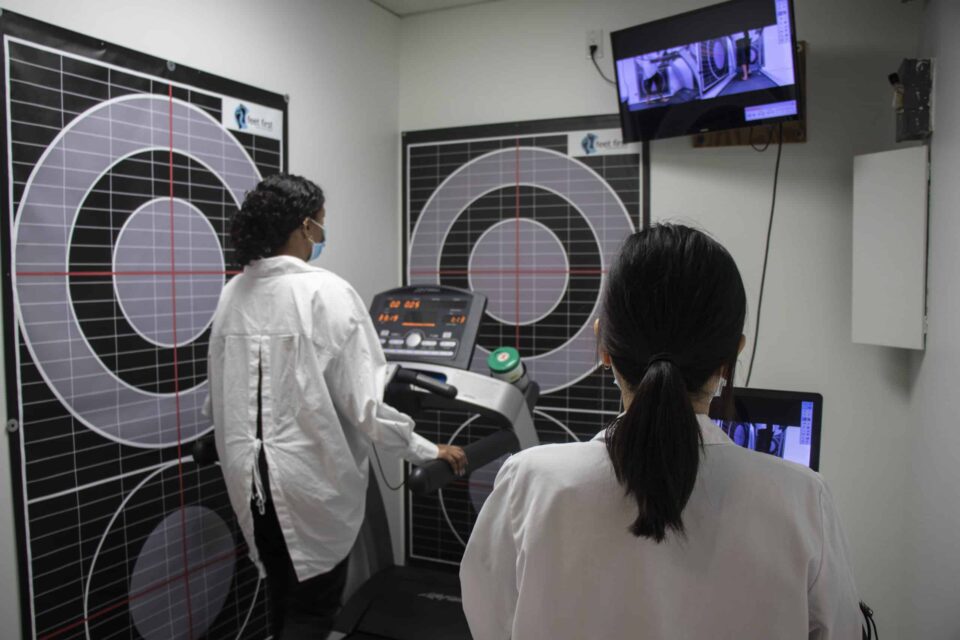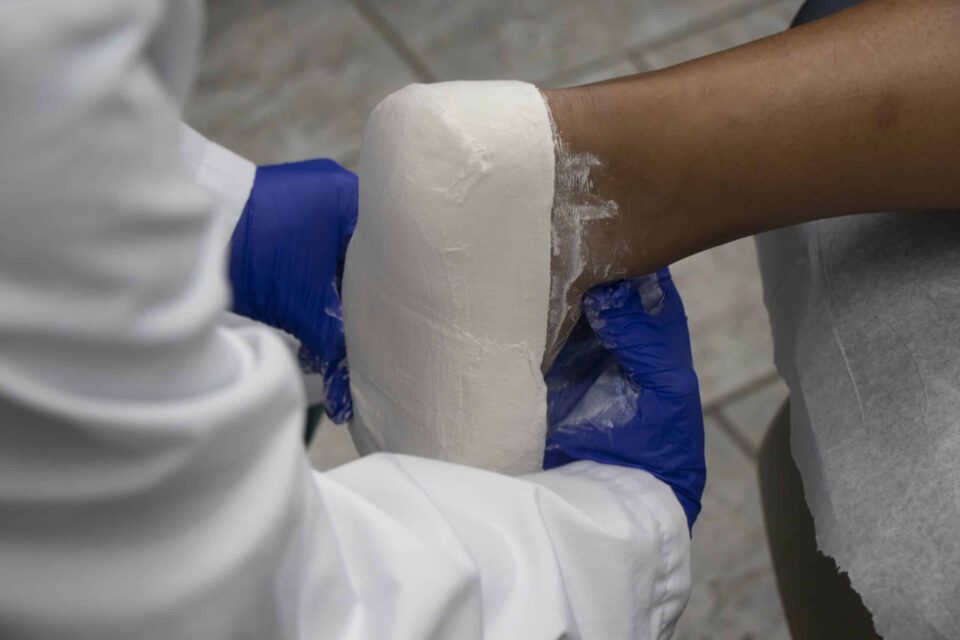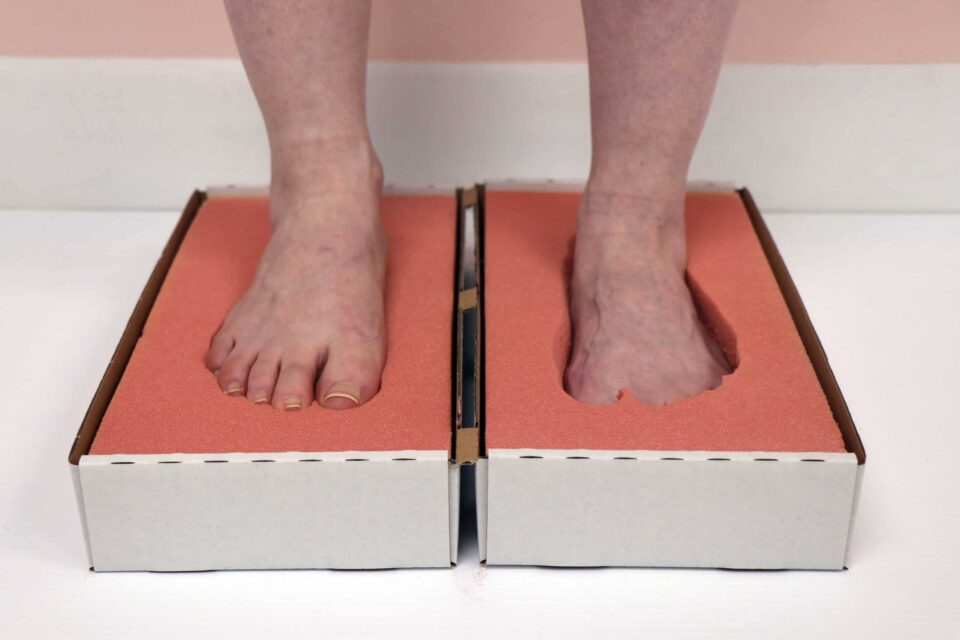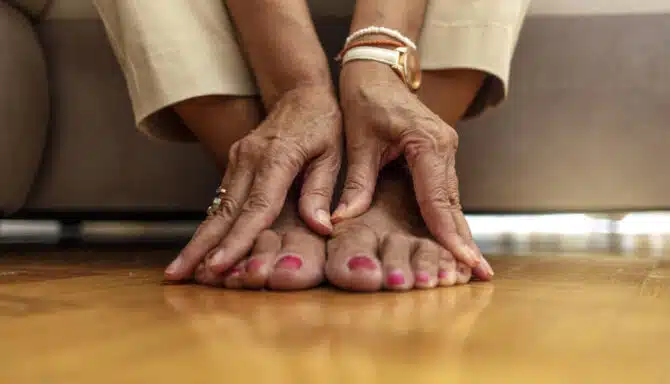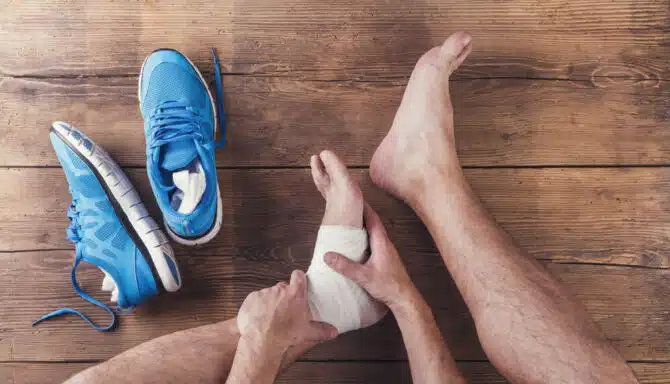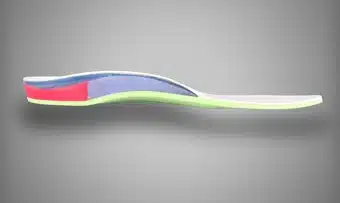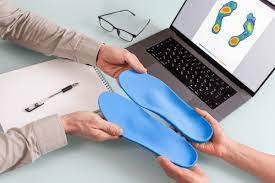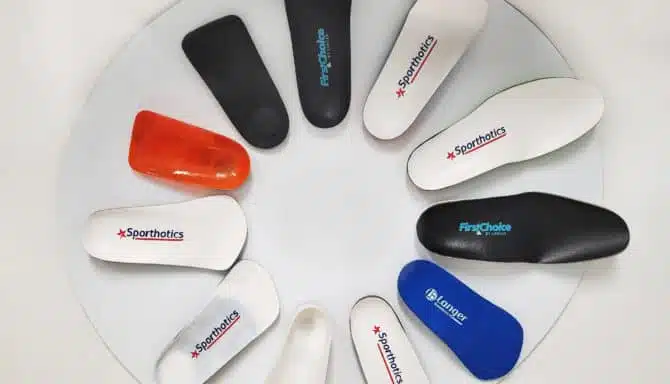November 21, 2024
Bunions can target anyone, but they are more common in older women due to factors like foot anatomy and footwear choices. Luckily, there are ways you can prevent and manage bunions to the best of your ability, especially if you work with a chiropodist or podiatrist. Let’s explore everything there is to know about bunions, including the reasons why older women are more at risk for developing bunions.
This article will answer:
What are bunions?
Who's at risk?
Why are older women at risk?
How do you treat bunions?
How do you prevent bunions?
Do I need bunion surgery?
What Are Bunions?
Bunions are toe deformities in which the big toe shifts towards the second toe at an angle. This causes the joint at the base of the big toe (the first metatarsophalangeal joint, or MTP joint) to protrude outwards, forming a bump that can become swollen, tender, and uncomfortable. The MTP joint bears a lot of pressure while walking or standing, which can worsen the bunion over time. As the condition progresses, people with bunions often experience pain and difficulty wearing certain shoes.
Another related condition common in older women is hallux rigidus, where arthritis or stiffness affects the big toe joint, limiting its movement. Hallux rigidus may not cause the same protrusion as bunions, but it can still lead to pain and difficulty moving the toe. Many people may think that hallux rigidus is the same as a bunion, but they are different - the scientific term for bunions is hallux valgus.
Causes of Bunions: Who's at Risk?
Bunions are caused by excessive prolonged stress on the MTP joint at the base of the big toe. Therefore, anything that increases pressure on the big toe can cause or contribute to bunions. While bunions aren't typically caused by one thing alone, there are several risk factors that contribute to the likelihood of developing bunions. All these risk factors either weaken or cause extra strain on the MTP joint. These include:
Age: Bunions can start to form as young as 30, but they are commonly associated with seniors and become more debilitating and noticeable with age. Some studies suggest 1 in 3 people over the age of 65 have a pronounced bunion, many of them being women.
Genetics: Bunions are partly genetic because foot shape and structure, often inherited traits, can increase the risk of developing them. People with certain foot shapes—particularly flat feet—are more prone to bunions because this structure creates imbalanced pressure on the big toe joint.
Wearing ill-fitting footwear: Frequently wearing narrow, tight, or high-heeled shoes that squeeze the toes can push the big toe inward, contributing to bunion formation. Pointed, unstready high-heeled shoes with very thin heels (like stilettos) are extra risky.
Having Rheumatoid arthritis: Conditions that affect joint health and increase inflammation, such as rheumatoid arthritis, can lead to bunion formation.
Previous foot injuries: Tendon tears, or having broken a bone in the past, can increase risk.
Why are Older Women at Risk?
Senior women are more likely than other groups to experience painful bunions for a handful of reasons:
Older people are more susceptible to joint-wear-and-tear and other foot conditions like osteoarthritis (which is caused by wear-and-tear on the joints, and is commonly associated with age). And pre-existing joint issues make you more prone to bunions.
Many older women have a history of wearing ill-fitting shoes with cramped toe boxes and unsteady high heels for decades. Tight shoes and high heels put extra strain and pressure on the MTP joint. The collective effects of this pressure accumulate over time and, compounded with other age-related risk factors, can accelerate, contribute to or exacerbate the formation of bunions.
Women may have weaker connective tissue in their feet. This will reduce the big toe's ability to withstand the force and pressure of our movement.
Bunions can worsen during menopause due to hormonal changes loosening ligaments and flattening the feet, making them more vulnerable. This can also happen during pregnancy and have long-lasting effects on the feet. Menopause can also affect bone density, which can accelerate joint degeneration, weaken joints, and therefore aggravate bunions.
Bunions in Older Women: Treatment
If you’re a woman (or anyone!) struggling with bunion pain, visiting a foot specialist, like a chiropodist or podiatrist, at your local foot clinic can help. There are many solutions available that target the foot pain and mobility issues associated with bunions, while decreasing pressure on the big toe joint. While bunions cannot be reversed (without surgery), by strengthening your feet and reducing pressure on the big toe, you can manage the bunion growth so that it doesn't get worse.
Bunion Exercises and Stretches
https://www.youtube.com/shorts/H3SogJ8FIas
A chiropodist or podiatrist may suggest some bunion exercises and stretches. These are great for both prevention and treatment, mostly target the toes, are easy to memorize, and accommodate seniors. The exercises may feel awkward at first, but you’ll get used to them in no time.
Here are five easy-to-learn exercises you can incorporate into your daily routine to help manage bunion discomfort:
Toe Circles
Grip your big toe and move it in circular motions to maintain joint mobility. Do 10 circles in each direction per foot.
Toe Stretches
Use your fingers to press your big toe down and hold for 30 seconds, then stretch it in the opposite direction for another 30 seconds. Repeat 5 times on each foot.
Towel Grip and Pull
Place a towel on the floor and use your toes to scrunch and pull it toward you. This helps strengthen the small muscles in your feet.
Toe Curls and Spreads
Curl your toes down tightly, hold for a few seconds, then spread them wide. Repeat this motion 10 times per foot to improve flexibility and strength.
Toe Resistance Exercises
View this post on Instagram A post shared by Feet First Clinic (@feetfirstclinic_)
Use your fingers to apply light pressure against your big toe in various directions, pressing up, down, and sideways. Hold each for 10 seconds. Repeat 5 times on each foot.
You can also wrap a resistance band around your big toes and then spread your feet apart while keeping your heels planted, as shown in the video above.
Other bunion treatment options provided by a foot specialist include:
Footwear recommendations: We'll get more into this later, but opt for shoes with a wide toe box that give your toes enough room. You should also look for features like cushioned insoles and good arch support to reduce pressure on the bunion.
Custom orthotics: A foot specialist will assess your feet and design custom orthotic insoles tailored to your feet. Orthotics work by reducing pressure and force on the big toe joint, which will then reduce bunion pain and help prevent the bunion from getting worse. Custom orthotics for bunions provide support and help realign the foot, redistributing pressure away from the bunion. You can then put the orthotics into your footwear and go about your daily activities with less pressure on the big toe.
Shockwave therapy: This treatment uses powerful acoustic pulses to reduce pain in the affected area by increasing blood flow and triggering a process that helps the body heal injured tissue. While shockwave therapy doesn't target the bunion itself, it helps with the tight muscles and ligaments around the bunion, which reduces pain and pressure on the joint.
Bunion devices: These devices help realign the toes to varying degrees. Silicone toe separators are great for when you're walking around at home, whereas ultra-thin bunion aligners fit comfortably in most footwear and are great for athletic people. For more significant correction, rigid bunion splints help stabilize the joint.
Therapeutic taping: A foot specialist can apply therapeutic tape to provide support, reduce pain, and help correct the alignment of the bunion, allowing for better mobility.
Shoe stretching: If your shoes are too tight, professional shoe stretching can help relieve pressure on the bunion, making footwear more comfortable.
https://www.youtube.com/shorts/8g43ZWreZ1g
Best Bunion Prevention Tips
There isn’t much you can do about your genetics or age, but you can be mindful about other lifestyle factors to manage bunion formation.
Wearing the Right Footwear
The best preventative measure you can take to try and avoid bunions is wearing the right shoes for your feet.
You should be especially vigilant about finding shoes that are wide enough for your toes to rest comfortably and wiggle without crowding and overlapping. Ideally, your shoes need between ⅜” to ½” of space between the end of your longest toe and the front of the shoe. You can try an at-home test to see how wide your feet really are before visiting your Toronto foot clinic for a shoe fitting that will help you find the perfect fit.
Toe space is the biggest factor for bunion prevention, but there are many other things to consider when finding the right shoes. Check out the best footwear for healthy feet to learn what else you should look out for.
Try to avoid high heels, only wearing them for special occasions. Even then, opt for healthy heel options. Heels shouldn’t be too high or too thin—look for a block, shorter heel or wedges instead. Your shoes also shouldn’t be severely pointed and squish your toes together.
Additional Bunion Prevention Tips:
Regular exercise and a good fitness regimen will help keep your muscles strong. Strong muscles reduce strain on the joints, which will then make you less susceptible to joint degeneration and wear-and-tear as you age. In addition, a healthy conditioned lower body and core helps with alignment and weight-bearing, meaning your big toe won't need to work as hard when you move around.
Since having a previous injury can be a risk factor, practice healthy foot injury prevention and FALL prevention.
If you notice early signs of bunion formation, such as redness or swelling around the big toe joint, consult a foot specialist promptly.
You should also consult a foot specialist if you have any family members with bunions, notice any issues with your alignment, have flat feet, or any other biomechanical concerns, as faulty biomechanics increase strain on the big toe joint.
Excess weight can put additional pressure on your feet, increasing the risk of bunion development. Maintaining a healthy weight can help reduce this strain.
Do I Need Bunion Surgery?
Bunion surgery, or bunionectomies, are invasive procedures that require local anesthesia, incisions, bone realignment and sometimes bone removal. While they can be immensely helpful, many folks want to avoid surgery, if possible, for these reasons:
Recovery time, which can take around six weeks.
A fear of complications (although they’re incredibly rare)
Cost. Bunionectomies are much more expensive than other treatments.
They don't address the underlying issues that caused the bunion to form in the first place
Seniors may be more likely to seek a bunionectomy after living with bunions for a longer period than young people, and trying other non-invasive treatment options with a podiatrist or chiropodist first.
That said, these days there are more non-surgical treatment options than ever before and your chances of needing a surgery are still somewhat low. Surgeries are typically only recommended for older women or any individual who experiences significant pain or functional limitations; surgeries are not usually performed solely for cosmetic reasons.
Visit your local Toronto foot clinic to address bunions before seeking surgery. You’ll start with a full foot assessment to determine the severity of your condition and your foot specialist will form a treatment plan with you.
https://www.youtube.com/shorts/XZUfVhny5pY
November 14, 2024
Foot injuries can increase in cold weather, so it’s important to learn how to minimize your risk, practice fall prevention, and navigate slippery conditions. Not only that, but cold weather can cause muscle stiffness to worsen, making your feet more vulnerable than they were during the warmer months. Today we’ll talk about 3 safety tips—recommended by the foot specialists at our Toronto foot clinic—to prevent winter foot injuries.
3 Tips to Prevent Winter Foot Injuries
Wear The Right Shoes
Try Warm Ups and Foot Exercises
Wear Supportive Insoles
1. Wear The Right Shoes
The wrong winter boots can lead to numerous foot injuries. While fashion may be your top priority, you shouldn’t sacrifice protective and supportive features just for looks (plus, you can find fashionable and comfortable shoes at our Toronto foot clinic). Winter footwear should have good shock absorption and be made with waterproof materials. Avoid pointed toes and high heels in the winter—these features are a recipe for slips and falls!
Stability And Motion Control Shoes
Did you know there are different foot types, and your foot type can determine what shoes you should wear? For example, people with flat feet need extra stability or motion control features built into their shoes to help correct varying degrees of overpronation (when the ankle rolls inward during movement). A foot specialist, like a podiatrist or chiropodist, can assess your feet and tell you what type shoes you should be wearing:
Stability Shoes
Purpose: Stability shoes are aimed at those with mild to moderate overpronation (the inward rolling of the foot when walking or running).
Features: These shoes typically have a supportive structure and posting around the arch and midsole to help guide the foot through a natural gait cycle and promote natural foot motion.
Motion Control Shoes
Purpose: These are designed for people with severe overpronation, providing maximum support to prevent excessive inward rolling of the foot.
Features: Motion control shoes are more rigid and structured than stability shoes, with reinforced areas in the midsole.
How does this link back to winter foot safety? If you have flat feet, especially if you’re a senior, and your feet overpronate, your hips, knees and ankles can weaken and become more painful and vulnerable due to years of walking with an abnormal gait. If you don’t have strong feet and joints, icy conditions become that much more threatening.
Both stability and motion control shoes can help prevent winter foot injuries by providing extra support and control in conditions where icy, wet, or uneven surfaces make slips and strains more likely. Keep in mind these should also have solid traction performance!
https://www.youtube.com/shorts/TnDaLrqYTac
Traction Performance
High traction performance in shoes (thick, rubber soles with grooves) is essential for winter injury prevention. It prevents slips and falls, which are especially common on icy or wet surfaces. Without reliable traction, even the smallest patch of ice can turn into a serious hazard, causing the foot to slide out from under the body and throwing balance off entirely. This can lead to falls, which are a primary cause of winter injuries, including sprains, fractures, and ligament tears in the foot, ankle, or knee.
Good traction provides a stable, controlled grip on unpredictable surfaces, allowing each step to connect firmly with the ground. This stability reduces the risk of unexpected slips and ensures that the foot can maintain contact without sliding, even on slippery patches. People who enjoy running during the winter months should particularly focus on finding running shoes with traction. Many brands, like Saucony or ASICS, design shoes for this purpose. You can also add on ice cleats or cramp-ons to your footwear for extra grip when running on icy surfaces.
When looking for traction performance, keep in mind that no shoes are built for traction on ice (although some may fare better than others). Only ice cleats or cramp-ons will provide proper grip on ice.
2. Try Warm-ups And Foot Exercises
Before going for a run, warm up your feet and lower extremities with a nice, healthy stretch or foot exercise. This will prepare your feet for pounding the pavement (or snow) and give them an added layer of strength and protection. Runners should be doing this year round as part of their foot care routine, not just during the winter!
These routines are not just for runners! Quite the opposite, in fact; they help people with mobility constraints and inflamed, weakened and damaged muscles/joints just as much as they do athletes.
People with arthritis in the feet, plantar fasciitis and other conditions can help reduce their risk of winter injuries by strengthening their feet. For example, arthritis can lead to joint pain, stiffness, and reduced range of motion, making it challenging to maintain balance on slippery or uneven surfaces. On the other hand, plantar fasciitis involves inflammation of the plantar fascia, the ligament that runs along the bottom of the foot. The discomfort may lead to altered walking mechanics, such as favoring one foot over the other, which can compromise stability and increase the risk of falls.
Stretches and exercises should target the intrinsic (small, stabilizing muscles located within the foot) and extensor muscles (primarily found in the lower leg), and your ankles. Your routine should include a variety of movements that target as many muscle groups as possible.
Here are a few easy, effective stretches and exercises you can start today:
https://www.youtube.com/shorts/gOwgyrmU6hM
Toe Splays: While seated or standing, spread (or "splay") your toes as wide apart as possible, holding for a few seconds, then releasing. Repeat this 10–15 times per foot.
Toe Flex and Raise: Stand with toes planted and lift the heels off the ground. This exercise strengthens the lower leg and foot muscles, improving balance and stability on icy surfaces.
Ankle Circles: Sit or stand and slowly rotate each ankle in circles, first clockwise and then counterclockwise. This helps increase ankle mobility and flexibility, which can reduce the risk of sprains.
Seated Hamstring Stretch: Sit on a chair, extend one leg straight in front. Lean forward slowly until you feel the stretch in your hamstring. Hold for about 30 seconds.
In addition, click here for part 1 and part 2 for the best exercises for arthritis, and here for the best exercises for plantar fasciitis.
https://www.youtube.com/shorts/AsuUXJYnUmQ
The Importance of Balance
We all know the direct link between losing your balance and sustaining an injury. We also know that people with disabilities or conditions that impact mobility need to be extra vigilant. With every step, strong balance allows you to react as quickly as possible to unexpected changes in winter terrain and surfaces, which will keep you safe.
Here are two simple foot exercises that focus on improving balance:
Single-Leg Stands: Stand on one foot for 20–30 seconds, then switch. This exercise builds balance and strengthens the muscles around the ankle, reducing the risk of falls on uneven surfaces.
Heel-to-Toe Walk: Walk in a straight line, placing the heel of one foot directly in front of the toes of the other. This exercise improves balance and strengthens stabilizing muscles.
3. Wear Supportive Insoles
Winter footwear is typically built for the elements - not for comfort. Therefore, it can be very difficult to find a supportive winter boot that will also protect your feet from winter weather. Fortunately, if you wear a supportive insole with your footwear, you won't need to sacrifice comfort for function. There are two types of supportive insoles you can wear with winter footwear: customer orthotics and over-the-counter insoles.
Custom Orthotics
Custom orthotics are designed to fit the unique contours of an individual's feet, helping to redistribute pressure and provide the necessary arch support. This is especially beneficial for individuals with flat feet or other conditions. Add winter to the mix, and this becomes even more crucial. By optimizing foot alignment, custom orthotics help maintain stability and balance, allowing individuals to navigate slippery surfaces with greater confidence.
Custom orthotics can be made to fit in winter boots or winter running shoes, to keep your foot supported in all scenarios. They can even come in half-lengths to accommodate dress shoes for when you’re leaving the office and heading to your car (slippery sidewalks are everywhere in winter, so you can’t be too careful!). They provide cushioning that absorbs impact and reduces strain on the joints, particularly the ankles and knees, which are crucial during winter activities like walking, shoveling snow, or participating in winter sports.
To learn if you can benefit from custom orthotics, you can consult a foot specialist like a chiropodist or a podiatrist.
Check out these resources on custom orthotics to learn even more:
5 Ways Orthotics Can Be Customized for Maximum Comfort and Support
The Role of Orthotics in Supporting Foot Health and Correcting Alignment
Understanding Different Types of Custom Orthotics: How to Choose the Right Support for Your Feet
https://www.youtube.com/shorts/IBXAXoUouFY
Over-the-Counter Insoles (Superfeet)
Over-the-counter insoles, like Superfeet, are also a great option to upgrade your winter footwear. Superfeet insoles have a deep heel cup, pronounced arch and a rigid, durable structure. They come in a variety of arch heights and cushioning levels to accommodate many foot conditions, like high arches, flat feet, plantar fasciitis and more! Whereas custom orthotics are custom-designed to your foot, Superfeet come in standard sizes and designs (each representing a different colour). They therefore can be more economical than custom orthotics.
If you're interested in Superfeet insoles, bring your winter shoes to our Toronto foot clinic. You can then try different Superfeet options to see which one works best for you. Different insoles feel different in different shoes, so we strongly recommend trying on your Superfeet with your winter shoes before purchasing them.
October 7, 2024
Many people don’t know what goes into their custom orthotics – not just the materials, but the technology that creates a comfortable orthotic. In this post, learn about all the different accomodations and orthotic customizations available to make your feet happy!
https://www.youtube.com/shorts/IBXAXoUouFY?feature=share
What Are Orthotic Customizations and Accomodations
Additions and Accommodations are very common parts of custom orthotics. They are used if a normal over-the-counter insole just won’t cut it. For example, if a patient has a neuroma or a misaligned gait, an orthotic without custom support won’t have anywhere near the same effectiveness. Here is a list of the most common orthotic customizations and accommodations for custom orthotics.
Heel Modifications
Firstly we have heel modifications. These are some of the most common additions to keep your feet comfortable and supported:
Cushion – Adds additional padding and shock absorption on the heel. Heel cushions cover the whole heel. Cushioning the heel is helpful for a variety of foot conditions, like plantar fasciitis and arthritis. It essentially reduces the strain and impact of your step.
Lift – Heel lifts can balance out differences in leg height and to prevent overpronation or supination. They can also be used to help with Achillies tendonitis. They're made of a harder material for balance.
Hole – Heel holes are used to help with heel spurs. Cushioning can be added to increase comfort and distribute pressure in the heel.
Seat – A Heel seat gives the patient more control if they overpronate. It's designed to hold the fatty tissue under the calcaneus in place.
Metatarsal Modifications
These orthotic customizations are designed to take pressure off of your metatarsals (the ball of your foot). They are helpful for anyone experiencing foot pain at the ball of their foot just below the toes.
1st Ray Cutout - Helps to offload pressure off 1st metatarsal head (the big toe). This is used to help with bunions and arthritis.
2-4 Metatarsal Pad – This is a teardrop shaped pad that sits below the metatarsals. It takes some of the load off the metatarsals by offloading pressure at ball of foot and elevating the second, third, and fourth metatarsals.
Metatarsal Bar – This is similar to 2-4 metatarsal pads, but has more surface area and offloads more pressure from the metatarsal heads. It can provide more stress relief in some cases.
Neuroma Pad – This is a small pad that sits between metatarsals and spreads them apart. It is designed to correct the transverse arch and help with pain in the metatarsals. As the name suggests, it is can help people experiencing a Morton's neuroma.
Arch Support
Moving on, we have arch support, which is important for everyone - regardless of whether you have a foot condition - but moreso for people who struggle with plantar fasciitis and arch pain.
Arch Pad – Additonal support on the arch for patients who need more arch support.
Fill – Arch fills make the orthotic more rigid. This is used to help the orthotic to support more weight. It can also be used to help somewhat with controlling the midtarsal joints.
Additional Accommodations
Finally, we have modifications that don't really fit into the previous categories. These are all very common additions that are often put in orthotics:
Morton’s Extension – Extra length under 1st metatarsal to keep it rigid. It helps during the push off phase of gait and can be rigid if patient has hallux rigidus or limitus. It immobilizes and offsets pressure on the first met joint.
Reverse Morton’s – This increases the mobility of the first met joint. The pad sits under the 2nd to the 5th met head and ends before the first.
Dancer Pad – Offloads the ball of the foot. It works by taking weight off of the big toe joint and dispersing it.
Scaphoid Pad - This is used to help support the mid and back foot. Helps take pressure off the joints and bones in the arch.
While these are the most common accommodations found on orthotics, there are many more! To learn more about how orthotics can be modified and customized to suit your unique foot needs, check out this Website.
What Orthotic is Right For Me?
A licensed chiropodist can determine what orthotic customizations and features are best for you. The chiropodist would first do a biomechanical assessment and gait analysis. They'll then diagnose your foot condition and make recommendations. Remember - orthotics are just one part of the equation when it comes to treating foot pain. While they can be beneficial for many common foot conditions, it's recommended to also explore other treatment options first, like supportive footwear, exercises and stretches.
If your chiropodist recommends orthotics, they'll discuss the different options and customizations available, and which ones will work best for your foot condition. They'll also take into account your activities and the footwear you'd be wearing the orthotics with. The chiropodist will then take a 3D scan of your foot and send it off to the lab to make your orthotics. You would then see the chiropodist a few weeks later for a fitting appointment, at which time the chiropodist will check that the orthotics are constructed properly and working the way they should. If everything checks out, you can take them home! We also recommend coming back about 6 to 8 weeks after your fitting for a follow-up appointment to see if your orthotics are helping with your foot pain. If they aren't, the chiropodist can modify the orthotics.
https://www.youtube.com/shorts/pO5oWb6S5MA?feature=share
September 26, 2024
Orthotics are supportive, custom devices designed to improve the alignment and function of the feet, ankles, and lower limbs. They aim to address specific issues like flat feet, overpronation, or arch support. This can help alleviate discomfort and prevent injuries by redistributing pressure and correcting abnormal movement patterns. Adequately fitted orthotics can significantly enhance comfort and mobility, making daily activities more manageable and pain-free.
Custom orthotics can make a big difference, but how exactly do orthotics correct foot alignment? And how do they work? Let's explain.
What are orthotics?
Orthotics are specialized, custom-designed insoles that you place inside your shoes. They come in many forms, and are molded and constructed specific to your unique foot needs. Their main job is to support and correct the alignment of your feet, which can help address various foot and lower limb issues. They essentially promote healthy biomechanics to ensure your body moves the way it's designed to.
Orthotics are custom-made specifically for your feet by a chiropodist (foot specialist). The chiropodist will do a biomechanical and gait analysis, and then take a mold of your foot (typically with a 3D digital scanner). The chiropodist then custom-designs the orthotics according to your specific needs, and a lab then constructs the orthotics according to the chiropodist's instructions.
It's important to note that while orthotics can be beneficial, they may not be suitable for everyone and can have some drawbacks, such as initial discomfort and the need for regular maintenance. Custom orthotics are more expensive than over-the-counter options, but they are an investment in your future — they may allow you to avoid more severe issues and chronic pain long-term, and can address foot concerns that over-the-counter insoles cannot. Not to mention, they are longer-lasting.
How orthotics correct foot alignment?
Orthotics are meant to modify how your foot moves and distributes pressure. They can help with several conditions, including:
Flat feet: Orthotics can support fallen arches to maintain and prop up the natural contours of your foot.
High arches: When you have high arches, excessive pressure is placed over a very small area of your foot. Orthotics help by cushioning and distributing pressure more evenly. If pressure is unevenly distributed across your feet, you're at a higher risk of overworking neighbouring parts of your foot.
Overpronation: If your feet roll inward too much when you walk or run (called "overpronation), orthotics can help correct this movement. They do this by creating a barrier to your foot's inward movement, which corrects the overpronation. (Interesting fact: people with flat feet are prone to overpronation, so the treatment for the two conditions is often the same).
Heel pain: Orthotics can reduce the strain on the plantar fascia and help alleviate heel pain.
By correcting foot alignment, orthotics can provide significant relief from pain and prevent future issues. The feet are our body's foundation, so when your feet are moving properly, it helps the rest of our body move properly. That allows muscles and joints to work the way they were designed to without being over-stressed. This then helps reduce pain - not only in our feet, but the rest of our body too!
Types of orthotics
There are many different types of orthotics designed for different footwear and activities. Click here to learn more!
Benefits beyond pain relief
Orthotics don't just help with pain—they can also play a proactive role in enhancing overall foot and body health. Proper alignment can lead to better posture, reduced knee and hip stress, and improved gait. Athletes often use orthotics to boost performance by optimizing foot mechanics, which then reduces the strain on the rest of their joints.
How to choose the right orthotics
If you're considering orthotics, here's what to keep in mind:
Consult a professional: A chiropodist can help determine if you need custom orthotics through a biomechanical assessment. They can then prescribe, design and fit your orthotics based on your activities and specific foot concerns. A chiropodist may also recommend footwear and over-the-insole options to test out first before going the custom route.
Consider your activities: Choose orthotics that match your lifestyle. For instance, if you're a runner, look for ones designed to absorb shock and provide stability. If you work in a setting with a formal dress code, you may want to opt for slimmer dress orthotics that will fit into your dress shoes.
Look at the full picture: Orthotics alone likely won't solve all your foot concerns. They're just part of the equation. You'll also want to ensure your wearing proper footwear and maintaining an active, healthy lifestyle. If you have chronic pain or a conditions like arthritis, regular exercise and stretching is very important to build strength in your feet and ankles. Orthotics are essentially meant to supplement a healthy lifestyle - not substitute it.
How to get the most out of your orthotics
Once you have your orthotics, wear them regularly to see the best results. They take some time to get used to, so gradually increase the time you wear them daily. Also, remember that orthotics are just one part of foot health—maintaining a proper exercise routine and suitable footwear are equally important. To ensure the longevity of your orthotics, clean them regularly and follow any specific care instructions provided by the manufacturer or your chiropodist.
September 23, 2024
The leaves are starting to change colour and the temperatures are taking a dip! What does that mean for your feet? A lot! Seasonal changes have a big impact on our foot health, which is why it's important to prepare your feet for fall — especially if you have a foot condition. To help you our, we compiled our Toronto foot specialists' top foot care tips for fall to keep your feet comfortable and healthy as you transition into cooler days. From selecting the right footwear to vigilant skin care, a little preparation can go a long way in keeping you cozy and supported.
Moisturizing, Skin Care and Protection
We all get thirsty, and the same thing happens to your skin — especially when the summer’s humidity is replaced with colder air that prevents it from retaining moisture.
One of the best ways to prepare your feet for fall is by focusing on hydrating your skin. Moisturizing your feet regularly will help you fight painful issues, like cracked heels. Incorporate a rich foot cream, like Gehwol’s Salve for Cracked Skin, if you notice dry cracks in your heels.
For a more preventative approach, moisturize every day to lock in moisture and keep your skin soft, and then exfoliate to remove dead skin cells. This lets the moisturizer penetrate deeply. Try the universally beneficial Soft Feet Cream from Gehwol; it binds moisture to the deepest layers of the skin and strengthens its natural defence. Learn more with our comprehensive moisturizing guide.
Fall Shoe Tips and Supportive Fall Footwear
Cold air can exacerbate foot pain by messing with your blood circulation. Healthy shoes can help offset this and make a world of difference.
Look for cozy fall boots, ideal for everyday wear. These include ankle boots with sturdy soles, a solid grip to prevent falls, good arch support, and cushioning. Additionally, consider shoes made from waterproof materials, like Gore-Tex fabric, to protect against the elements. Not only will this help with fall foot comfort, but it will also keep your feet dry and warm as the weather cools down. Damp feet can cause issues like infections and foot odour.
For those extra cold days, you should wear boots with soft materials, like fleece or shearling, for insulation against the cold. You never know when the snow falls and below-zero temperatures will begin, so having a pair of boots like this ready to wear is always wise.
Lastly, your fall shoes might work even better if you wear them with custom orthotics or high-quality Superfeet insoles. Ask your chiropodist if they can help you.
Our Toronto foot clinic is known for our excellent shoe shopping tips, particularly for the fall and winter. We can also provide a complimentary shoe fitting service for when you don’t know where to start with your fall shoe hunting.
Foot Conditions Requiring Extra Care in Fall
If you have arthritis or diabetes, fall foot care is even more important. That's why one of our top fall foot care tips is to pay close attention to your foot health and regularly visit your chiropodist so they can keep an eye on your feet - especially if you have vulnerable feet.
Arthritis sufferers may find that the cold exacerbates joint stiffness and pain. The lower temperatures can cause muscles to tighten, putting additional strain on already sensitive joints.
For people with diabetes, the reduced blood circulation can be extra dangerous and worsen the body’s already compromised healing abilities. Ulcers, infections and even frostbite can be big problems during the chilly months.
September 16, 2024
You may have heard of custom orthotics before, (if not, check out this article) but did you know that there are many different types of custom orthotics? Orthotics range from sports orthotics to dress orthotics, and everything in between. In this article we will cover the different types of custom orthotics you can choose, and what might be best for your feet.
Custom Orthotics
Custom Orthotics are the most common type of orthotic. Easily accessible and slipped into shoes, these provide maximum support and can help with foot problems like plantar fasciitis or Morton’s neuroma. Custom orthotics are also ideal simply if you want more comfort and support when walking around during everyday tasks. All of the orthotics below are some kind of custom orthotic. You can also find many examples of these orthotics on this website.
Sports Orthotics
These orthotics are ideal for people who are often running, jumping, and doing high impact activates on a regular basis. Sports orthotics can be easily modified to fit the sport you're doing. For example, if you were a basketball player who Is doing lots of jumping, the orthotic would be made with extra shock absorption. Sports orthotics are designed to help with common sports conditions like plantar fasciitis. They are made semi-rigid to provide the optimal balance between comfort and control.
Casual Orthotics
If you enjoy going on walks but often have pain in your feet, casual orthotics may be the way to go. These orthotics are meant for walking and standing for long periods of time and can provide comfort that you may not otherwise get from your regular shoes. Casual Orthotics are also great because they are easy to transfer between shoes and are low profile, meaning they're relatively, so you can wear them with shoes that don't have removable insoles. Casual orthotics are typically rigid or semi-rigid depending on your foot condition.
Dress Orthotics
Like casual orthotics, dress orthotics are meant for long periods of standing and walking. The main difference between the two is the size. Dress orthotics are designed to be slimmer and fit into the smaller shape of dress shoes. Because of the limited space, some orthotics may have to sacrifice width and support; however they will still provide relief from uncomfortable shoes.
Accommodative Orthotics:
Accommodative orthotics are designed for people that have more severe issues with foot pain and comfort. This can include arthritis, foot deformities, and diabetes. They tend to have a soft and cushioned top cover. These orthotics are mostly flexible to be nicer on the feet, however they can also be semi-rigid if the user needs more control.
Children's Orthotics
Childrens orthotics differ from adults because children are growing constantly. Often, children are prescribed orthotics to correct an issue that would be present in their adult life if not corrected. Children may get several different pairs of orthotics as they grow older to accomodate their changing feet. Children's orthotics are made for comfort as well as correction, so that your little one can be comfortable running around.
Conclusion
There are many different types of orthotics available that can easily accomodate your footwear and activities. They're also a great way to upgrade your favourite shoes. Whether you want comfort or control, there is always an option for you.
